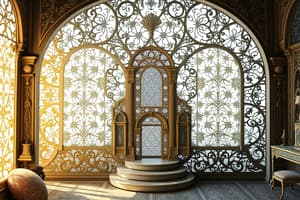Podcast
Questions and Answers
What is kinetic art?
What is kinetic art?
- A genre of art that only includes canvas paintings
- A genre of art that is purely mathematical
- A genre of art that only includes sculptures and figures
- A genre of art that contains movement perceivable by the viewer or that depends on motion for its effect (correct)
Who are some of the artists that experimented with accentuating the movement of human figures on canvas?
Who are some of the artists that experimented with accentuating the movement of human figures on canvas?
- Jackson Pollock, Max Bill, and Vladimir Tatlin
- Claude Monet, Edgar Degas, and Édouard Manet (correct)
- Jean Tinguely, George Rickey, and Len Lye
- Bridget Riley, Yacov Agam, and Jesús Rafael Soto
Who is considered the unchallenged leader of kinetic painters?
Who is considered the unchallenged leader of kinetic painters?
- Alexander Calder
- Jackson Pollock (correct)
- Max Bill
- Vladimir Tatlin
What is the definition of mobiles in kinetic art?
What is the definition of mobiles in kinetic art?
What is virtual movement in kinetic art?
What is virtual movement in kinetic art?
Who is considered the father of Constructivism?
Who is considered the father of Constructivism?
What is neo-kinetic art?
What is neo-kinetic art?
Where can large-scale kinetic installations by international artists be found?
Where can large-scale kinetic installations by international artists be found?
Who are some selected kinetic op artists?
Who are some selected kinetic op artists?
Flashcards
Kinetic Art
Kinetic Art
A form of art that involves movement, perceivable by the viewer or through interaction. It encompasses a wide range of techniques and styles, including paintings with multidimensional movement, sculptures that move naturally or are machine-operated, and virtual movement perceived from certain angles.
Virtual Movement
Virtual Movement
A type of kinetic art where the movement is perceived from only certain angles or sections of the work.
Non-Objectivism
Non-Objectivism
A style of kinetic art where objects of different materials are juxtaposed to create new ideas and spark the viewer's imagination. This approach is characterized by its focus on the interplay of materials and form.
Alexander Calder
Alexander Calder
Signup and view all the flashcards
Object Mobile
Object Mobile
Signup and view all the flashcards
Op Art
Op Art
Signup and view all the flashcards
Neo-Kinetic Art
Neo-Kinetic Art
Signup and view all the flashcards
Machine-Operated Kinetic Art
Machine-Operated Kinetic Art
Signup and view all the flashcards
Mobile
Mobile
Signup and view all the flashcards
Study Notes
Kinetic art is a genre of art that contains movement perceivable by the viewer or that depends on motion for its effect, and encompasses a wide variety of techniques and styles. It includes canvas paintings that incorporate multidimensional movement and three-dimensional sculptures and figures such as mobiles that move naturally or are machine operated. There is also a portion of kinetic art that includes virtual movement, or rather movement perceived from only certain angles or sections of the work. Kinetic art has its origins in the late 19th century impressionist artists such as Claude Monet, Edgar Degas, and Édouard Manet who originally experimented with accentuating the movement of human figures on canvas. The surrealist style of the 20th century created an easy transition into the style of kinetic art. Jackson Pollock, who used tools that most painters would never use, such as sticks, trowels, and knives, is considered the unchallenged leader of kinetic painters. Max Bill believed that kinetic art should be executed from a purely mathematical perspective. Mobiles are no longer considered mobiles when the spectator has control over their movement. Kinetic art principles have also influenced mosaic art. Vladimir Tatlin is considered by many artists and art historians to be the father of Constructivism.Kinetic Art: A Brief History
- Vladimir Tatlin's Contre-Reliefs Libérés Dans L'espace (1915) was the first mobile sculpture that relied on mathematical interlocking of planes to create a rhythm similar to Pollock's work.
- Tatlin's Tower was a monumental kinetic architectural design for the Comintern (the Third International) that was never built.
- Alexander Rodchenko's non-objectivism approach to art was a study that focused on juxtaposing objects of different materials to spark new ideas in the viewer's mind.
- Alexander Calder is an artist who defined the style of mobiles in kinetic art with his two types of mobiles: object mobiles and suspended mobiles.
- Calder's earliest object mobiles had very little to do with kinetic art or moving art, but he became recognized for his apparent originality in mobile construction.
- Virtual movement is a style of kinetic art that can be associated with mobiles, and Victor Vasarely created many works that were considered to be interactive in the 1940s.
- Apparent movement and op art are two specific distinctions of kinetic art that evolved in the 1950s and 1960s.
- Neo-kinetic art has been popular in China, where interactive kinetic sculptures can be found in many public places.
- Changi Airport in Singapore has a curated collection of artworks, including large-scale kinetic installations by international artists.
- Selected kinetic sculptors include Jean Tinguely, George Rickey, and Len Lye.
- Selected kinetic op artists include Bridget Riley, Yacov Agam, and Jesús Rafael Soto.
- Other notable works of kinetic art include the Water Motor (1913) by Marcel Duchamp and the Tinguely Fountain (1977) in Basel, Switzerland.
Studying That Suits You
Use AI to generate personalized quizzes and flashcards to suit your learning preferences.




